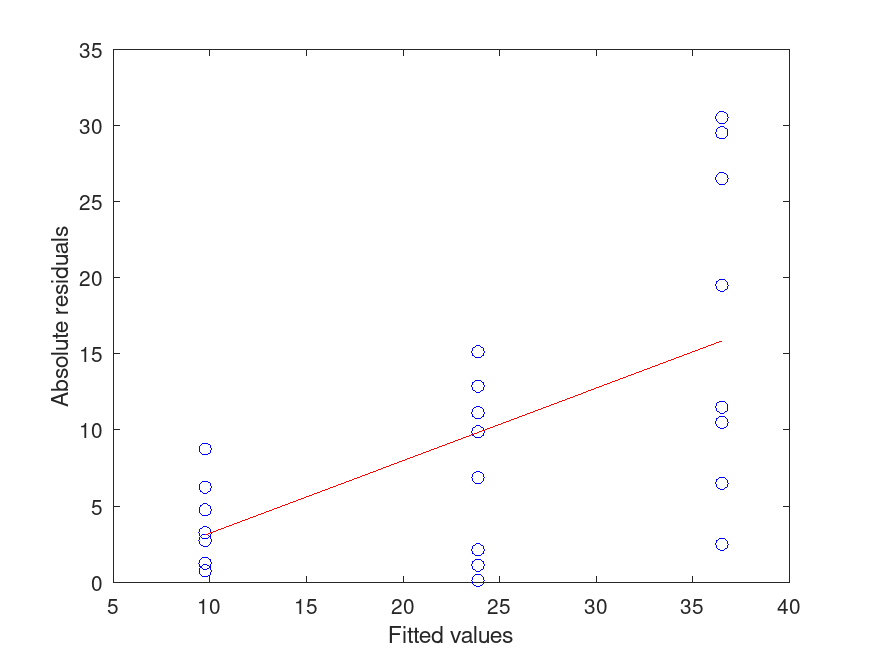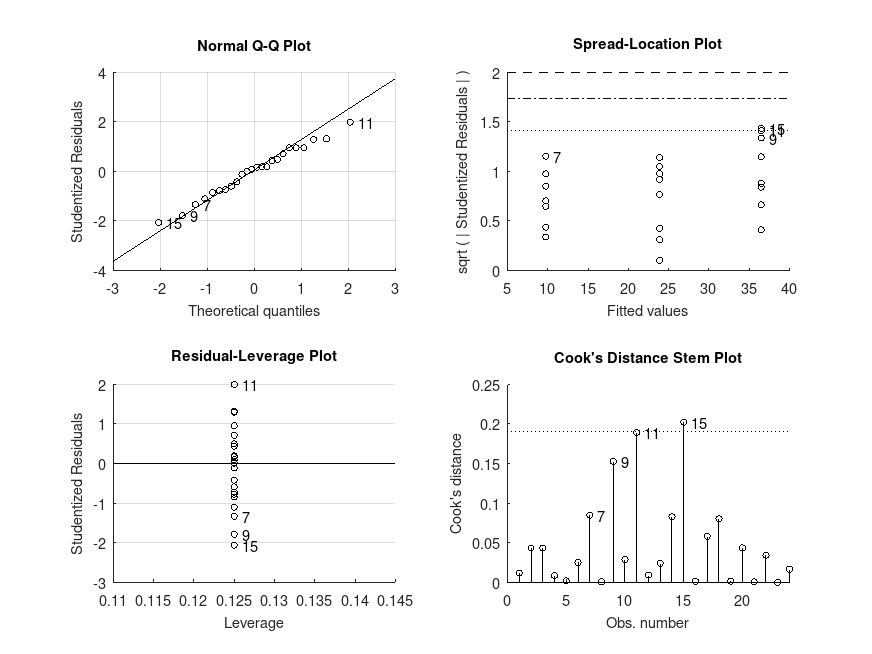Categories &
Functions List
- BetaDistribution
- BinomialDistribution
- BirnbaumSaundersDistribution
- BurrDistribution
- ExponentialDistribution
- ExtremeValueDistribution
- GammaDistribution
- GeneralizedExtremeValueDistribution
- GeneralizedParetoDistribution
- HalfNormalDistribution
- InverseGaussianDistribution
- LogisticDistribution
- LoglogisticDistribution
- LognormalDistribution
- LoguniformDistribution
- MultinomialDistribution
- NakagamiDistribution
- NegativeBinomialDistribution
- NormalDistribution
- PiecewiseLinearDistribution
- PoissonDistribution
- RayleighDistribution
- RicianDistribution
- tLocationScaleDistribution
- TriangularDistribution
- UniformDistribution
- WeibullDistribution
- betafit
- betalike
- binofit
- binolike
- bisafit
- bisalike
- burrfit
- burrlike
- evfit
- evlike
- expfit
- explike
- gamfit
- gamlike
- geofit
- gevfit_lmom
- gevfit
- gevlike
- gpfit
- gplike
- gumbelfit
- gumbellike
- hnfit
- hnlike
- invgfit
- invglike
- logifit
- logilike
- loglfit
- logllike
- lognfit
- lognlike
- nakafit
- nakalike
- nbinfit
- nbinlike
- normfit
- normlike
- poissfit
- poisslike
- raylfit
- rayllike
- ricefit
- ricelike
- tlsfit
- tlslike
- unidfit
- unifit
- wblfit
- wbllike
- betacdf
- betainv
- betapdf
- betarnd
- binocdf
- binoinv
- binopdf
- binornd
- bisacdf
- bisainv
- bisapdf
- bisarnd
- burrcdf
- burrinv
- burrpdf
- burrrnd
- bvncdf
- bvtcdf
- cauchycdf
- cauchyinv
- cauchypdf
- cauchyrnd
- chi2cdf
- chi2inv
- chi2pdf
- chi2rnd
- copulacdf
- copulapdf
- copularnd
- evcdf
- evinv
- evpdf
- evrnd
- expcdf
- expinv
- exppdf
- exprnd
- fcdf
- finv
- fpdf
- frnd
- gamcdf
- gaminv
- gampdf
- gamrnd
- geocdf
- geoinv
- geopdf
- geornd
- gevcdf
- gevinv
- gevpdf
- gevrnd
- gpcdf
- gpinv
- gppdf
- gprnd
- gumbelcdf
- gumbelinv
- gumbelpdf
- gumbelrnd
- hncdf
- hninv
- hnpdf
- hnrnd
- hygecdf
- hygeinv
- hygepdf
- hygernd
- invgcdf
- invginv
- invgpdf
- invgrnd
- iwishpdf
- iwishrnd
- jsucdf
- jsupdf
- laplacecdf
- laplaceinv
- laplacepdf
- laplacernd
- logicdf
- logiinv
- logipdf
- logirnd
- loglcdf
- loglinv
- loglpdf
- loglrnd
- logncdf
- logninv
- lognpdf
- lognrnd
- mnpdf
- mnrnd
- mvncdf
- mvnpdf
- mvnrnd
- mvtcdf
- mvtpdf
- mvtrnd
- mvtcdfqmc
- nakacdf
- nakainv
- nakapdf
- nakarnd
- nbincdf
- nbininv
- nbinpdf
- nbinrnd
- ncfcdf
- ncfinv
- ncfpdf
- ncfrnd
- nctcdf
- nctinv
- nctpdf
- nctrnd
- ncx2cdf
- ncx2inv
- ncx2pdf
- ncx2rnd
- normcdf
- norminv
- normpdf
- normrnd
- plcdf
- plinv
- plpdf
- plrnd
- poisscdf
- poissinv
- poisspdf
- poissrnd
- raylcdf
- raylinv
- raylpdf
- raylrnd
- ricecdf
- riceinv
- ricepdf
- ricernd
- tcdf
- tinv
- tpdf
- trnd
- tlscdf
- tlsinv
- tlspdf
- tlsrnd
- tricdf
- triinv
- tripdf
- trirnd
- unidcdf
- unidinv
- unidpdf
- unidrnd
- unifcdf
- unifinv
- unifpdf
- unifrnd
- vmcdf
- vminv
- vmpdf
- vmrnd
- wblcdf
- wblinv
- wblpdf
- wblrnd
- wienrnd
- wishpdf
- wishrnd
- adtest
- anova1
- anova2
- anovan
- bartlett_test
- barttest
- binotest
- chi2gof
- chi2test
- correlation_test
- fishertest
- friedman
- hotelling_t2test
- hotelling_t2test2
- kruskalwallis
- kstest
- kstest2
- levene_test
- manova1
- mcnemar_test
- multcompare
- ranksum
- regression_ftest
- regression_ttest
- runstest
- sampsizepwr
- signrank
- signtest
- tiedrank
- ttest
- ttest2
- vartest
- vartest2
- vartestn
- ztest
- ztest2
Function Reference: anovan
statistics: p = anovan (Y, GROUP)
statistics: p = anovan (Y, GROUP, name, value)
statistics: [p, atab] = anovan (…)
statistics: [p, atab, stats] = anovan (…)
statistics: [p, atab, stats, terms] = anovan (…)
Perform a multi (N)-way analysis of (co)variance (ANOVA or ANCOVA) to
evaluate the effect of one or more categorical or continuous predictors (i.e.
independent variables) on a continuous outcome (i.e. dependent variable). The
algorithms used make anovan suitable for balanced or unbalanced
factorial (crossed) designs. By default, anovan treats all factors
as fixed. Examples of function usage can be found by entering the command
demo anovan. A bootstrap resampling variant of this function,
bootlm, is available in the statistics-resampling package and has
similar usage.
Data is a single vector Y with groups specified by a corresponding
matrix or cell array of group labels GROUP, where each column of
GROUP has the same number of rows as Y. For example, if
Y = [23; 27; 31; 29; 30; 32]; GROUP = [1, 2; 1, 3; 1, 2; 2, 3; 2, 3; 3, 2];
then observation 23 was measured under conditions 1,2; observation 27 was
measured under conditions 1,3; and so on. If the GROUP provided is empty,
then the linear model is fit with just the intercept (no predictors).
anovan can take a number of optional parameters as name-value pairs.
[…] = anovan (Y, GROUP, "continuous", continuous)
- continuous is a vector of indices indicating which of the columns (i.e. factors) in GROUP should be treated as continuous predictors rather than as categorical predictors. The relationship between continuous predictors and the outcome should be linear.
[…] = anovan (Y, GROUP, "random", random)
-
random is a vector of indices indicating which of the columns (i.e.
factors) in GROUP should be treated as random effects rather than
fixed effects. Octave
anovanprovides only basic support for random effects. Specifically, since all F-statistics inanovanare calculated using the mean-squared error (MSE), any interaction terms containing a random effect are dropped from the model term definitions and their associated variance is pooled with the residual, unexplained variance making up the MSE. In effect, the model then fitted equates to a linear mixed model with random intercept(s). Variable names for random factors are appended with a ’ symbol.
[…] = anovan (Y, GROUP, "model", modeltype)
-
modeltype can specified as one of the following:
- "linear" (default) : compute main effects with no interactions.
- "interaction" : compute effects and two-factor interactions
- "full" : compute the main effects and interactions at all levels
- a scalar integer : representing the maximum interaction order
- a matrix of term definitions : each row is a term and each column is a factor
-- Example: A two-way ANOVA with interaction would be: [1 0; 0 1; 1 1]
[…] = anovan (Y, GROUP, "sstype", sstype)
-
sstype can specified as one of the following:
- 1 : Type I sequential sums-of-squares.
- 2 or "h" : Type II partially sequential (or hierarchical) sums-of-squares
- 3 (default) : Type III partial, constrained or marginal sums-of-squares
[…] = anovan (Y, GROUP, "varnames", varnames)
- varnames must be a cell array of strings with each element containing a factor name for each column of GROUP. By default (if not parsed as optional argument), varnames are "X1","X2","X3", etc.
[…] = anovan (Y, GROUP, "alpha", alpha)
- alpha must be a scalar value between 0 and 1 requesting confidence bounds for the regression coefficients returned in stats.coeffs (default 0.05 for 95% confidence).
[…] = anovan (Y, GROUP, "display", dispopt)
- dispopt can be either "on" (default) or "off" and controls the display of the model formula, table of model parameters, the ANOVA table and the diagnostic plots. The F-statistic and p-values are formatted in APA-style. To avoid p-hacking, the table of model parameters is only displayed if we set planned contrasts (see below).
[…] = anovan (Y, GROUP, "contrasts", contrasts)
-
contrasts can be specified as one of the following:
-
A string corresponding to one of the built-in contrasts listed below:
- "simple" or "anova" (default): Simple (ANOVA) contrast coding. (The first level appearing in the GROUP column is the reference level)
- "poly": Polynomial contrast coding for trend analysis.
- "helmert": Helmert contrast coding: the difference between each level with the mean of the subsequent levels.
- "effect": Deviation effect coding. (The first level appearing in the GROUP column is omitted).
- "sdif" or "sdiff": Successive differences contrast coding: the difference between each level with the previous level.
- "treatment": Treatment contrast (or dummy) coding. (The first level appearing in the GROUP column is the reference level). These contrasts are not compatible with sstype = 3.
- A matrix containing a custom contrast coding scheme (i.e. the generalized inverse of contrast weights). Rows in the contrast matrices correspond to factor levels in the order that they first appear in the GROUP column. The matrix must contain the same number of columns as there are the number of factor levels minus one.
If the anovan model contains more than one factor and a built-in contrast coding scheme was specified, then those contrasts are applied to all factors. To specify different contrasts for different factors in the model, contrasts should be a cell array with the same number of cells as there are columns in GROUP. Each cell should define contrasts for the respective column in GROUP by one of the methods described above. If cells are left empty, then the default contrasts are applied. Contrasts for cells corresponding to continuous factors are ignored.
-
A string corresponding to one of the built-in contrasts listed below:
[…] = anovan (Y, GROUP, "weights", weights)
-
weights is an optional vector of weights to be used when fitting the
linear model. Weighted least squares (WLS) is used with weights (that is,
minimizing
sum (weights * residuals .^ 2)); otherwise ordinary least squares (OLS) is used (default is empty for OLS).
anovan can return up to four output arguments:
p = anovan (…) returns a vector of p-values, one for each
term.
[p, atab] = anovan (…) returns a cell array
containing the ANOVA table.
[p, atab, stats] = anovan (…) returns a
structure containing additional statistics, including degrees of freedom and
effect sizes for each term in the linear model, the design matrix, the
variance-covariance matrix, (weighted) model residuals, and the mean squared
error. The columns of stats.coeffs (from left-to-right) report the
model coefficients, standard errors, lower and upper
confidence interval bounds, t-statistics, and p-values relating to the
contrasts. The number appended to each term name in stats.coeffnames
corresponds to the column number in the relevant contrast matrix for that
factor. The stats structure can be used as input for multcompare.
[p, atab, stats, terms] = anovan (…)
returns the model term definitions.
See also: anova1, anova2, multcompare, fitlm
Source Code: anovan
Example: 1
# Two-sample unpaired test on independent samples (equivalent to Student's
# t-test). Note that the absolute value of t-statistic can be obtained by
# taking the square root of the reported F statistic. In this example,
# t = sqrt (1.44) = 1.20.
score = [54 23 45 54 45 43 34 65 77 46 65]';
gender = {"male" "male" "male" "male" "male" "female" "female" "female" ...
"female" "female" "female"}';
[P, ATAB, STATS] = anovan (score, gender, "display", "on", "varnames", "gender");
MODEL FORMULA (based on Wilkinson's notation):
Y ~ 1 + gender
ANOVA TABLE (Type III sums-of-squares):
Source Sum Sq. d.f. Mean Sq. R Sq. F Prob>F
--------------------------------------------------------------------------------
gender 318.11 1 318.11 0.138 1.44 .261
Error 1992.8 9 221.42
Total 2310.9 10
|

Example: 2
# Two-sample paired test on dependent or matched samples equivalent to a
# paired t-test. As for the first example, the t-statistic can be obtained by
# taking the square root of the reported F statistic. Note that the interaction
# between treatment x subject was dropped from the full model by assigning
# subject as a random factor (').
score = [4.5 5.6; 3.7 6.4; 5.3 6.4; 5.4 6.0; 3.9 5.7]';
treatment = {"before" "after"; "before" "after"; "before" "after";
"before" "after"; "before" "after"}';
subject = {"GS" "GS"; "JM" "JM"; "HM" "HM"; "JW" "JW"; "PS" "PS"}';
[P, ATAB, STATS] = anovan (score(:), {treatment(:), subject(:)}, ...
"model", "full", "random", 2, "sstype", 2, ...
"varnames", {"treatment", "subject"}, ...
"display", "on");
MODEL FORMULA (based on Wilkinson's notation):
Y ~ 1 + treatment + (1|subject)
ANOVA TABLE (Type II sums-of-squares):
Source Sum Sq. d.f. Mean Sq. R Sq. F Prob>F
--------------------------------------------------------------------------------
treatment 5.329 1 5.329 0.801 16.08 .016
subject' 1.674 4 0.4185 0.558 1.26 .413
Error 1.326 4 0.3315
Total 8.329 9
|
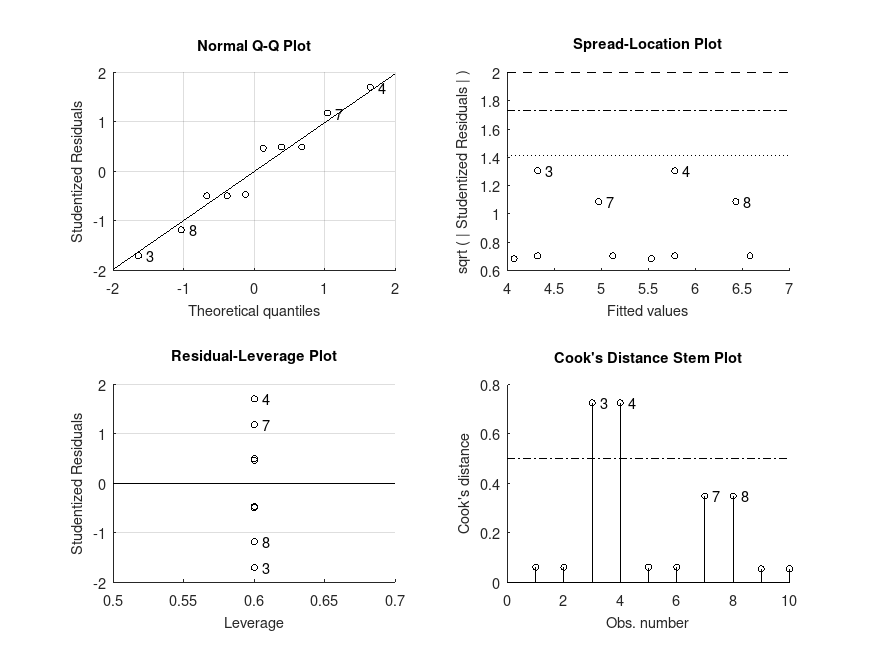
Example: 3
# One-way ANOVA on the data from a study on the strength of structural beams,
# in Hogg and Ledolter (1987) Engineering Statistics. New York: MacMillan
strength = [82 86 79 83 84 85 86 87 74 82 ...
78 75 76 77 79 79 77 78 82 79]';
alloy = {"st","st","st","st","st","st","st","st", ...
"al1","al1","al1","al1","al1","al1", ...
"al2","al2","al2","al2","al2","al2"}';
[P, ATAB, STATS] = anovan (strength, alloy, "display", "on", ...
"varnames", "alloy");
MODEL FORMULA (based on Wilkinson's notation):
Y ~ 1 + alloy
ANOVA TABLE (Type III sums-of-squares):
Source Sum Sq. d.f. Mean Sq. R Sq. F Prob>F
--------------------------------------------------------------------------------
alloy 184.8 2 92.4 0.644 15.40 <.001
Error 102 17 6
Total 286.8 19
|
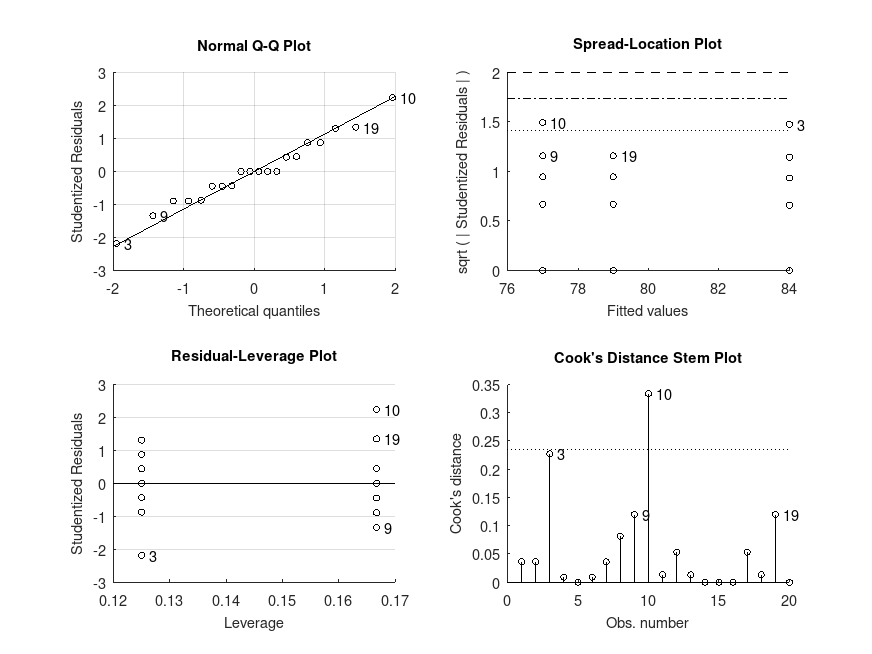
Example: 4
# One-way repeated measures ANOVA on the data from a study on the number of
# words recalled by 10 subjects for three time conditions, in Loftus & Masson
# (1994) Psychon Bull Rev. 1(4):476-490, Table 2. Note that the interaction
# between seconds x subject was dropped from the full model by assigning
# subject as a random factor (').
words = [10 13 13; 6 8 8; 11 14 14; 22 23 25; 16 18 20; ...
15 17 17; 1 1 4; 12 15 17; 9 12 12; 8 9 12];
seconds = [1 2 5; 1 2 5; 1 2 5; 1 2 5; 1 2 5; ...
1 2 5; 1 2 5; 1 2 5; 1 2 5; 1 2 5;];
subject = [ 1 1 1; 2 2 2; 3 3 3; 4 4 4; 5 5 5; ...
6 6 6; 7 7 7; 8 8 8; 9 9 9; 10 10 10];
[P, ATAB, STATS] = anovan (words(:), {seconds(:), subject(:)}, ...
"model", "full", "random", 2, "sstype", 2, ...
"display", "on", "varnames", {"seconds", "subject"});
MODEL FORMULA (based on Wilkinson's notation):
Y ~ 1 + seconds + (1|subject)
ANOVA TABLE (Type II sums-of-squares):
Source Sum Sq. d.f. Mean Sq. R Sq. F Prob>F
--------------------------------------------------------------------------------
seconds 52.267 2 26.133 0.825 42.51 <.001
subject' 942.53 9 104.73 0.988 170.34 <.001
Error 11.067 18 0.61481
Total 1005.9 29
|
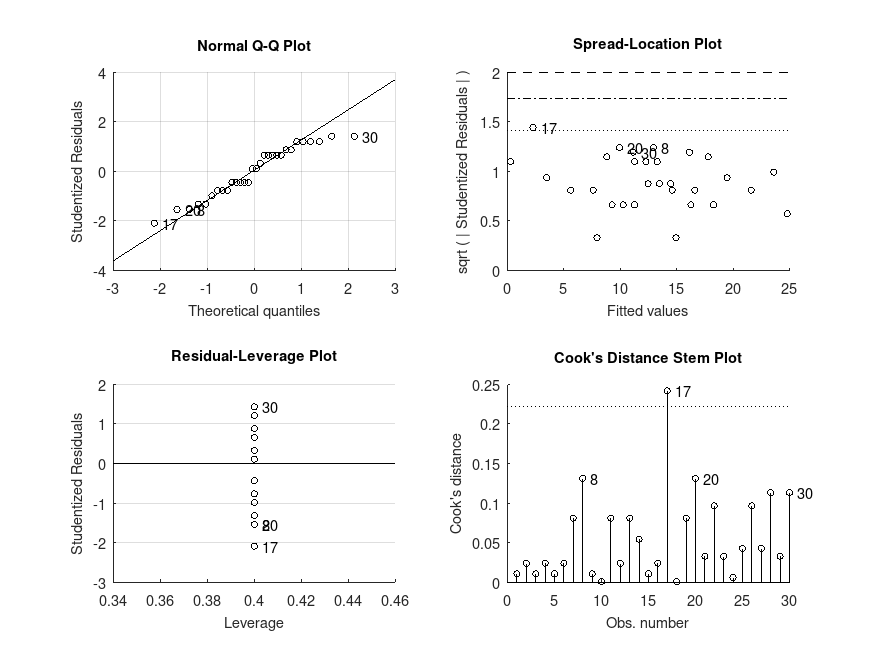
Example: 5
# Balanced two-way ANOVA with interaction on the data from a study of popcorn
# brands and popper types, in Hogg and Ledolter (1987) Engineering Statistics.
# New York: MacMillan
popcorn = [5.5, 4.5, 3.5; 5.5, 4.5, 4.0; 6.0, 4.0, 3.0; ...
6.5, 5.0, 4.0; 7.0, 5.5, 5.0; 7.0, 5.0, 4.5];
brands = {"Gourmet", "National", "Generic"; ...
"Gourmet", "National", "Generic"; ...
"Gourmet", "National", "Generic"; ...
"Gourmet", "National", "Generic"; ...
"Gourmet", "National", "Generic"; ...
"Gourmet", "National", "Generic"};
popper = {"oil", "oil", "oil"; "oil", "oil", "oil"; "oil", "oil", "oil"; ...
"air", "air", "air"; "air", "air", "air"; "air", "air", "air"};
[P, ATAB, STATS] = anovan (popcorn(:), {brands(:), popper(:)}, ...
"display", "on", "model", "full", ...
"varnames", {"brands", "popper"});
MODEL FORMULA (based on Wilkinson's notation):
Y ~ 1 + brands + popper + brands:popper
ANOVA TABLE (Type III sums-of-squares):
Source Sum Sq. d.f. Mean Sq. R Sq. F Prob>F
--------------------------------------------------------------------------------
brands 15.75 2 7.875 0.904 56.70 <.001
popper 4.5 1 4.5 0.730 32.40 <.001
brands*popper 0.083333 2 0.041667 0.048 0.30 .746
Error 1.6667 12 0.13889
Total 22 17
|
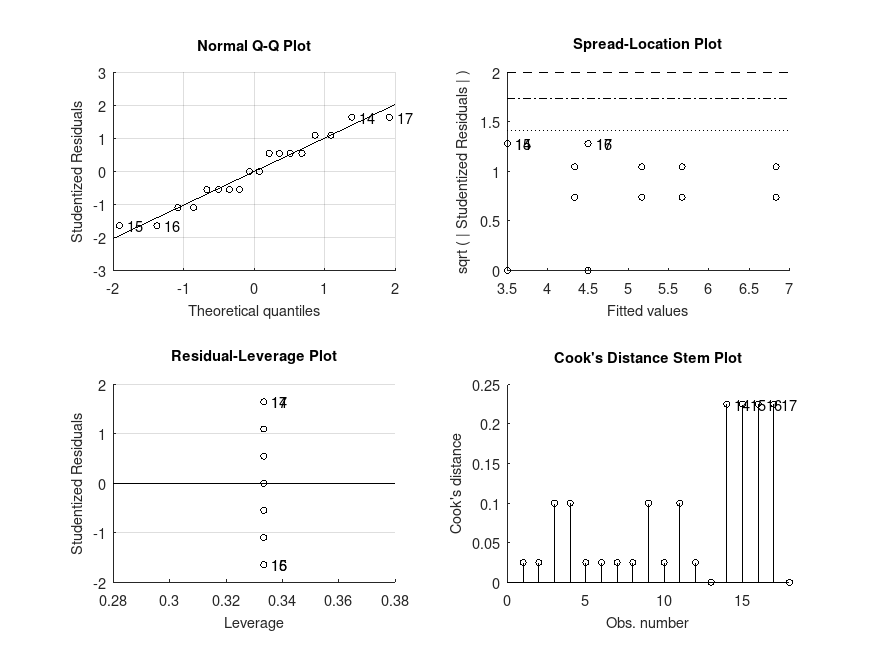
Example: 6
# Unbalanced two-way ANOVA (2x2) on the data from a study on the effects of
# gender and having a college degree on salaries of company employees,
# in Maxwell, Delaney and Kelly (2018): Chapter 7, Table 15
salary = [24 26 25 24 27 24 27 23 15 17 20 16, ...
25 29 27 19 18 21 20 21 22 19]';
gender = {"f" "f" "f" "f" "f" "f" "f" "f" "f" "f" "f" "f"...
"m" "m" "m" "m" "m" "m" "m" "m" "m" "m"}';
degree = [1 1 1 1 1 1 1 1 0 0 0 0 1 1 1 0 0 0 0 0 0 0]';
[P, ATAB, STATS] = anovan (salary, {gender, degree}, "model", "full", ...
"sstype", 3, "display", "on", "varnames", ...
{"gender", "degree"});
MODEL FORMULA (based on Wilkinson's notation):
Y ~ 1 + gender + degree + gender:degree
ANOVA TABLE (Type III sums-of-squares):
Source Sum Sq. d.f. Mean Sq. R Sq. F Prob>F
--------------------------------------------------------------------------------
gender 29.371 1 29.371 0.370 10.57 .004
degree 264.34 1 264.34 0.841 95.16 <.001
gender*degree 1.1748 1 1.1748 0.023 0.42 .524
Error 50 18 2.7778
Total 323.86 21
|

Example: 7
# Unbalanced two-way ANOVA (3x2) on the data from a study of the effect of
# adding sugar and/or milk on the tendency of coffee to make people babble,
# in from Navarro (2019): 16.10
sugar = {"real" "fake" "fake" "real" "real" "real" "none" "none" "none" ...
"fake" "fake" "fake" "real" "real" "real" "none" "none" "fake"}';
milk = {"yes" "no" "no" "yes" "yes" "no" "yes" "yes" "yes" ...
"no" "no" "yes" "no" "no" "no" "no" "no" "yes"}';
babble = [4.6 4.4 3.9 5.6 5.1 5.5 3.9 3.5 3.7...
5.6 4.7 5.9 6.0 5.4 6.6 5.8 5.3 5.7]';
[P, ATAB, STATS] = anovan (babble, {sugar, milk}, "model", "full", ...
"sstype", 3, "display", "on", ...
"varnames", {"sugar", "milk"});
MODEL FORMULA (based on Wilkinson's notation):
Y ~ 1 + sugar + milk + sugar:milk
ANOVA TABLE (Type III sums-of-squares):
Source Sum Sq. d.f. Mean Sq. R Sq. F Prob>F
--------------------------------------------------------------------------------
sugar 2.1318 2 1.0659 0.403 4.04 .045
milk 1.0041 1 1.0041 0.241 3.81 .075
sugar*milk 5.9439 2 2.9719 0.653 11.28 .002
Error 3.1625 12 0.26354
Total 13.62 17
|
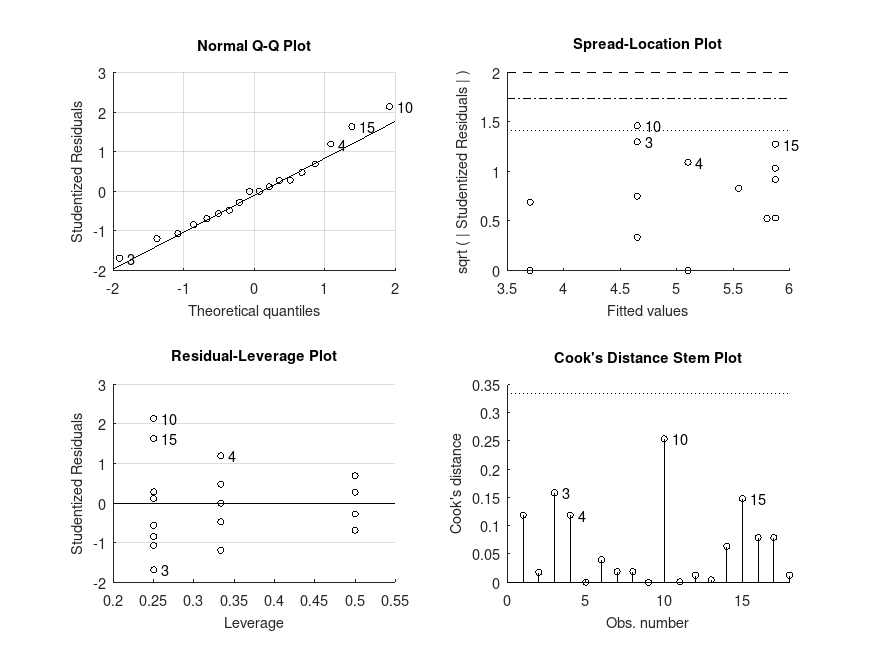
Example: 8
# Unbalanced three-way ANOVA (3x2x2) on the data from a study of the effects
# of three different drugs, biofeedback and diet on patient blood pressure,
# adapted* from Maxwell, Delaney and Kelly (2018): Chapter 8, Table 12
# * Missing values introduced to make the sample sizes unequal to test the
# calculation of different types of sums-of-squares
drug = {"X" "X" "X" "X" "X" "X" "X" "X" "X" "X" "X" "X" ...
"X" "X" "X" "X" "X" "X" "X" "X" "X" "X" "X" "X";
"Y" "Y" "Y" "Y" "Y" "Y" "Y" "Y" "Y" "Y" "Y" "Y" ...
"Y" "Y" "Y" "Y" "Y" "Y" "Y" "Y" "Y" "Y" "Y" "Y";
"Z" "Z" "Z" "Z" "Z" "Z" "Z" "Z" "Z" "Z" "Z" "Z" ...
"Z" "Z" "Z" "Z" "Z" "Z" "Z" "Z" "Z" "Z" "Z" "Z"};
feedback = [1 1 1 1 1 1 1 1 1 1 1 1 0 0 0 0 0 0 0 0 0 0 0 0;
1 1 1 1 1 1 1 1 1 1 1 1 0 0 0 0 0 0 0 0 0 0 0 0;
1 1 1 1 1 1 1 1 1 1 1 1 0 0 0 0 0 0 0 0 0 0 0 0];
diet = [0 0 0 0 0 0 1 1 1 1 1 1 0 0 0 0 0 0 1 1 1 1 1 1;
0 0 0 0 0 0 1 1 1 1 1 1 0 0 0 0 0 0 1 1 1 1 1 1;
0 0 0 0 0 0 1 1 1 1 1 1 0 0 0 0 0 0 1 1 1 1 1 1];
BP = [170 175 165 180 160 158 161 173 157 152 181 190 ...
173 194 197 190 176 198 164 190 169 164 176 175;
186 194 201 215 219 209 164 166 159 182 187 174 ...
189 194 217 206 199 195 171 173 196 199 180 NaN;
180 187 199 170 204 194 162 184 183 156 180 173 ...
202 228 190 206 224 204 205 199 170 160 NaN NaN];
[P, ATAB, STATS] = anovan (BP(:), {drug(:), feedback(:), diet(:)}, ...
"model", "full", "sstype", 3, ...
"display", "on", ...
"varnames", {"drug", "feedback", "diet"});
MODEL FORMULA (based on Wilkinson's notation):
Y ~ 1 + drug + feedback + diet + drug:feedback + drug:diet + feedback:diet + drug:feedback:diet
ANOVA TABLE (Type III sums-of-squares):
Source Sum Sq. d.f. Mean Sq. R Sq. F Prob>F
--------------------------------------------------------------------------------
drug 3430.9 2 1715.4 0.275 10.79 <.001
feedback 1833.7 1 1833.7 0.168 11.53 .001
diet 5080.5 1 5080.5 0.359 31.94 <.001
drug*feedback 382.08 2 191.04 0.040 1.20 .308
drug*diet 963.04 2 481.52 0.096 3.03 .056
feedback*diet 44.452 1 44.452 0.005 0.28 .599
drug*feedback*diet 814.35 2 407.17 0.082 2.56 .086
Error 9065.8 57 159.05
Total 22190 68
|
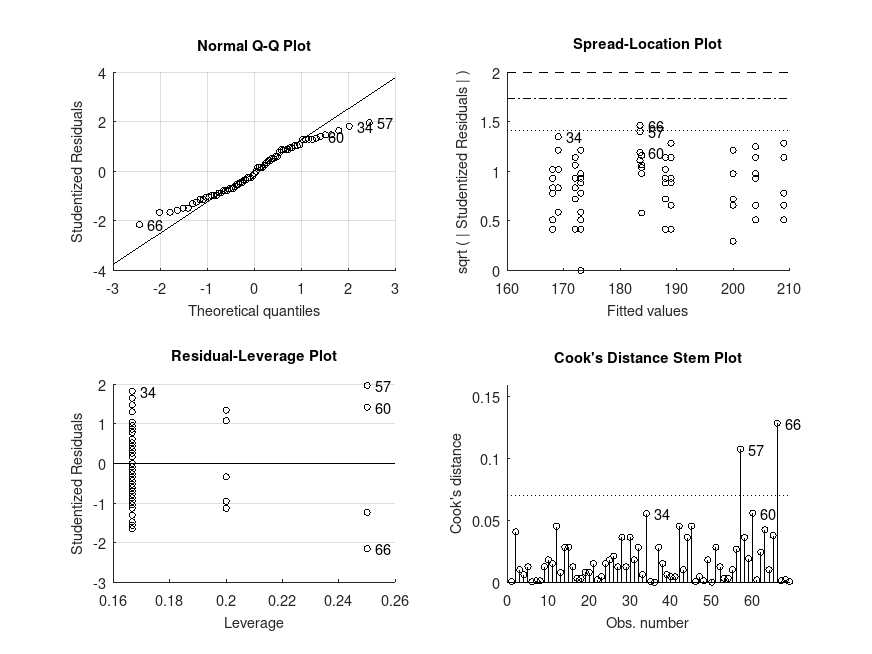
Example: 9
# Balanced three-way ANOVA (2x2x2) with one of the factors being a blocking
# factor. The data is from a randomized block design study on the effects
# of antioxidant treatment on glutathione-S-transferase (GST) levels in
# different mouse strains, from Festing (2014), ILAR Journal, 55(3):427-476.
# Note that all interactions involving block were dropped from the full model
# by assigning block as a random factor (').
measurement = [444 614 423 625 408 856 447 719 ...
764 831 586 782 609 1002 606 766]';
strain= {"NIH","NIH","BALB/C","BALB/C","A/J","A/J","129/Ola","129/Ola", ...
"NIH","NIH","BALB/C","BALB/C","A/J","A/J","129/Ola","129/Ola"}';
treatment={"C" "T" "C" "T" "C" "T" "C" "T" "C" "T" "C" "T" "C" "T" "C" "T"}';
block = [1 1 1 1 1 1 1 1 2 2 2 2 2 2 2 2]';
[P, ATAB, STATS] = anovan (measurement/10, {strain, treatment, block}, ...
"sstype", 2, "model", "full", "random", 3, ...
"display", "on", ...
"varnames", {"strain", "treatment", "block"});
MODEL FORMULA (based on Wilkinson's notation):
Y ~ 1 + strain + treatment + (1|block) + strain:treatment
ANOVA TABLE (Type II sums-of-squares):
Source Sum Sq. d.f. Mean Sq. R Sq. F Prob>F
--------------------------------------------------------------------------------
strain 286.13 3 95.378 0.580 3.23 .091
treatment 2275.3 1 2275.3 0.917 76.94 <.001
block' 1242.6 1 1242.6 0.857 42.02 <.001
strain*treatment 495.9 3 165.3 0.706 5.59 .028
Error 207.01 7 29.573
Total 4506.9 15
|
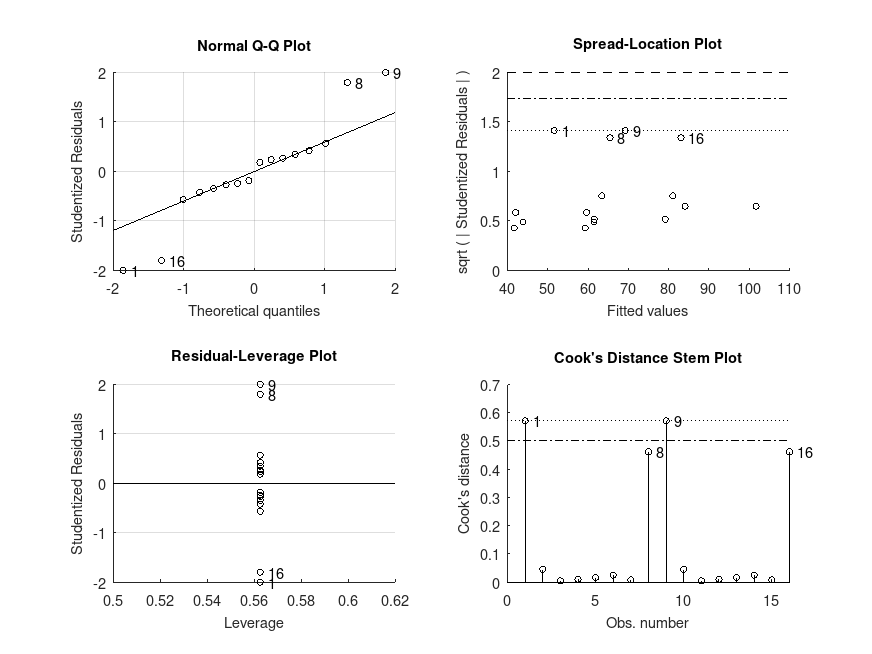
Example: 10
# One-way ANCOVA on data from a study of the additive effects of species
# and temperature on chirpy pulses of crickets, from Stitch, The Worst Stats
# Text eveR
pulse = [67.9 65.1 77.3 78.7 79.4 80.4 85.8 86.6 87.5 89.1 ...
98.6 100.8 99.3 101.7 44.3 47.2 47.6 49.6 50.3 51.8 ...
60 58.5 58.9 60.7 69.8 70.9 76.2 76.1 77 77.7 84.7]';
temp = [20.8 20.8 24 24 24 24 26.2 26.2 26.2 26.2 28.4 ...
29 30.4 30.4 17.2 18.3 18.3 18.3 18.9 18.9 20.4 ...
21 21 22.1 23.5 24.2 25.9 26.5 26.5 26.5 28.6]';
species = {"ex" "ex" "ex" "ex" "ex" "ex" "ex" "ex" "ex" "ex" "ex" ...
"ex" "ex" "ex" "niv" "niv" "niv" "niv" "niv" "niv" "niv" ...
"niv" "niv" "niv" "niv" "niv" "niv" "niv" "niv" "niv" "niv"};
[P, ATAB, STATS] = anovan (pulse, {species, temp}, "model", "linear", ...
"continuous", 2, "sstype", "h", "display", "on", ...
"varnames", {"species", "temp"});
MODEL FORMULA (based on Wilkinson's notation):
Y ~ 1 + species + temp
ANOVA TABLE (Type II sums-of-squares):
Source Sum Sq. d.f. Mean Sq. R Sq. F Prob>F
--------------------------------------------------------------------------------
species 598 1 598 0.870 187.40 <.001
temp 4376.1 1 4376.1 0.980 1371.35 <.001
Error 89.35 28 3.1911
Total 8582.2 30
|
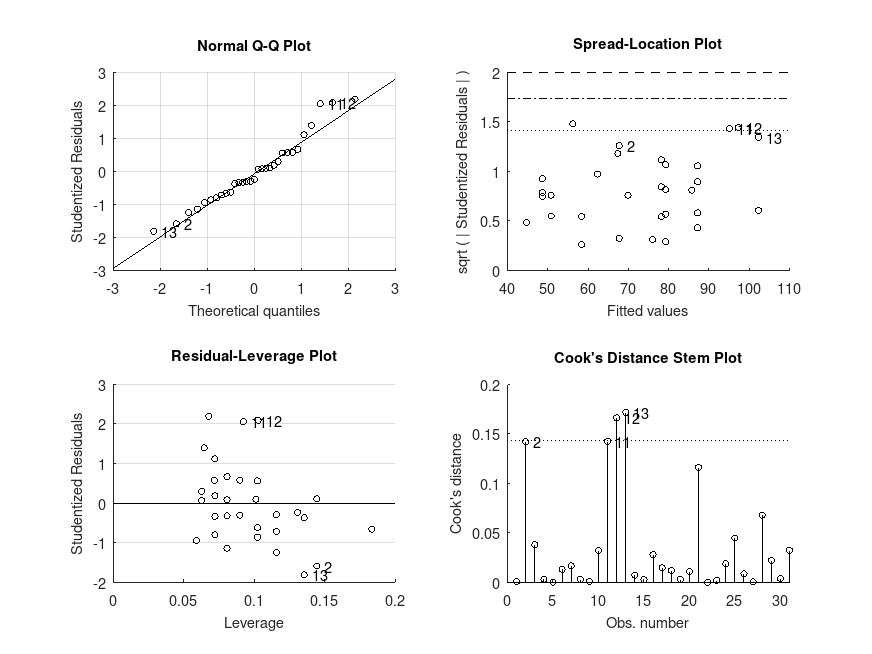
Example: 11
# Factorial ANCOVA on data from a study of the effects of treatment and
# exercise on stress reduction score after adjusting for age. Data from R
# datarium package).
score = [95.6 82.2 97.2 96.4 81.4 83.6 89.4 83.8 83.3 85.7 ...
97.2 78.2 78.9 91.8 86.9 84.1 88.6 89.8 87.3 85.4 ...
81.8 65.8 68.1 70.0 69.9 75.1 72.3 70.9 71.5 72.5 ...
84.9 96.1 94.6 82.5 90.7 87.0 86.8 93.3 87.6 92.4 ...
100. 80.5 92.9 84.0 88.4 91.1 85.7 91.3 92.3 87.9 ...
91.7 88.6 75.8 75.7 75.3 82.4 80.1 86.0 81.8 82.5]';
treatment = {"yes" "yes" "yes" "yes" "yes" "yes" "yes" "yes" "yes" "yes" ...
"yes" "yes" "yes" "yes" "yes" "yes" "yes" "yes" "yes" "yes" ...
"yes" "yes" "yes" "yes" "yes" "yes" "yes" "yes" "yes" "yes" ...
"no" "no" "no" "no" "no" "no" "no" "no" "no" "no" ...
"no" "no" "no" "no" "no" "no" "no" "no" "no" "no" ...
"no" "no" "no" "no" "no" "no" "no" "no" "no" "no"}';
exercise = {"lo" "lo" "lo" "lo" "lo" "lo" "lo" "lo" "lo" "lo" ...
"mid" "mid" "mid" "mid" "mid" "mid" "mid" "mid" "mid" "mid" ...
"hi" "hi" "hi" "hi" "hi" "hi" "hi" "hi" "hi" "hi" ...
"lo" "lo" "lo" "lo" "lo" "lo" "lo" "lo" "lo" "lo" ...
"mid" "mid" "mid" "mid" "mid" "mid" "mid" "mid" "mid" "mid" ...
"hi" "hi" "hi" "hi" "hi" "hi" "hi" "hi" "hi" "hi"}';
age = [59 65 70 66 61 65 57 61 58 55 62 61 60 59 55 57 60 63 62 57 ...
58 56 57 59 59 60 55 53 55 58 68 62 61 54 59 63 60 67 60 67 ...
75 54 57 62 65 60 58 61 65 57 56 58 58 58 52 53 60 62 61 61]';
[P, ATAB, STATS] = anovan (score, {treatment, exercise, age}, ...
"model", [1 0 0; 0 1 0; 0 0 1; 1 1 0], ...
"continuous", 3, "sstype", "h", "display", "on", ...
"varnames", {"treatment", "exercise", "age"});
MODEL FORMULA (based on Wilkinson's notation):
Y ~ 1 + treatment + exercise + age + treatment:exercise
ANOVA TABLE (Type II sums-of-squares):
Source Sum Sq. d.f. Mean Sq. R Sq. F Prob>F
--------------------------------------------------------------------------------
treatment 275.7 1 275.7 0.173 11.10 .002
exercise 1034.6 2 517.32 0.440 20.82 <.001
age 226.36 1 226.36 0.147 9.11 .004
treatment*exercise 220.94 2 110.47 0.144 4.45 .016
Error 1316.9 53 24.848
Total 3888.3 59
|
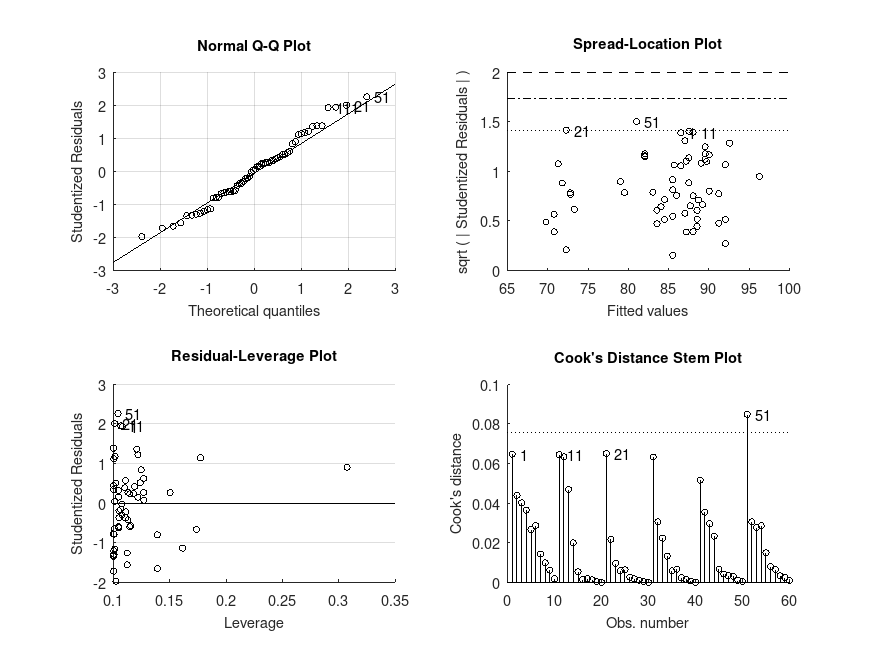
Example: 12
# Unbalanced one-way ANOVA with custom, orthogonal contrasts. The statistics
# relating to the contrasts are shown in the table of model parameters, and
# can be retrieved from the STATS.coeffs output.
dv = [ 8.706 10.362 11.552 6.941 10.983 10.092 6.421 14.943 15.931 ...
22.968 18.590 16.567 15.944 21.637 14.492 17.965 18.851 22.891 ...
22.028 16.884 17.252 18.325 25.435 19.141 21.238 22.196 18.038 ...
22.628 31.163 26.053 24.419 32.145 28.966 30.207 29.142 33.212 ...
25.694 ]';
g = [1 1 1 1 1 1 1 1 2 2 2 2 2 3 3 3 3 3 3 3 3 ...
4 4 4 4 4 4 4 5 5 5 5 5 5 5 5 5]';
C = [ 0.4001601 0.3333333 0.5 0.0
0.4001601 0.3333333 -0.5 0.0
0.4001601 -0.6666667 0.0 0.0
-0.6002401 0.0000000 0.0 0.5
-0.6002401 0.0000000 0.0 -0.5];
[P,ATAB, STATS] = anovan (dv, g, "contrasts", C, "varnames", "score", ...
"alpha", 0.05, "display", "on");
MODEL FORMULA (based on Wilkinson's notation):
Y ~ 1 + score
MODEL PARAMETERS (contrasts for the fixed effects)
Parameter Estimate SE Lower.CI Upper.CI t Prob>|t|
--------------------------------------------------------------------------------
(Intercept) 19.4 0.483 18.4 20.4 40.16 <.001
score_1 -9.33 0.969 -11.3 -7.36 -9.62 <.001
score_2 -5 1.31 -7.66 -2.34 -3.82 <.001
score_3 -8 1.64 -11.3 -4.66 -4.87 <.001
score_4 -8 1.45 -11 -5.04 -5.51 <.001
ANOVA TABLE (Type III sums-of-squares):
Source Sum Sq. d.f. Mean Sq. R Sq. F Prob>F
--------------------------------------------------------------------------------
score 1561.3 4 390.33 0.855 47.10 <.001
Error 265.17 32 8.2866
Total 1826.5 36
|
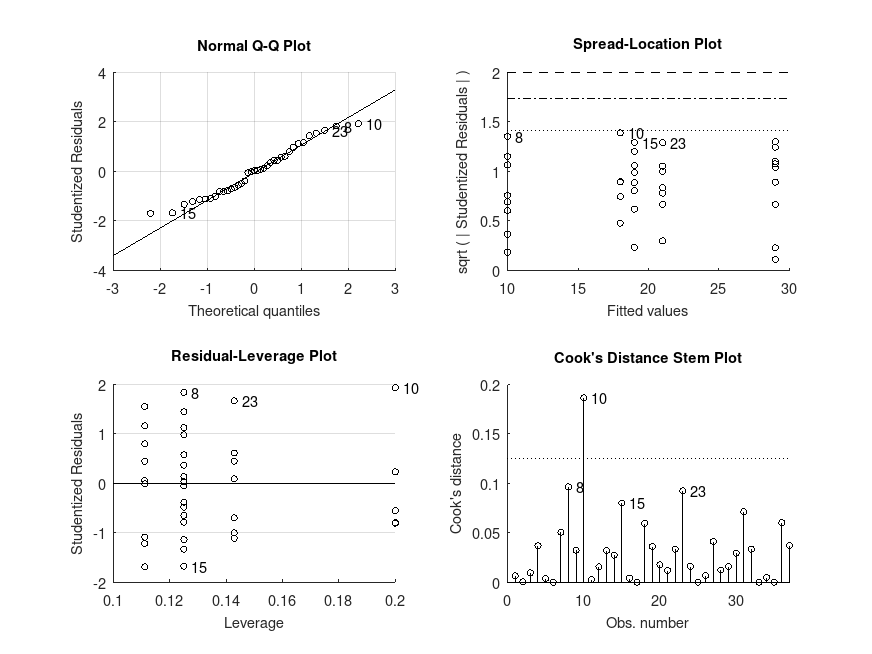
Example: 13
# One-way ANOVA with the linear model fit by weighted least squares to
# account for heteroskedasticity. In this example, the variance appears
# proportional to the outcome, so weights have been estimated by initially
# fitting the model without weights and regressing the absolute residuals on
# the fitted values. Although this data could have been analysed by Welch's
# ANOVA test, the approach here can generalize to ANOVA models with more than
# one factor.
g = [1, 1, 1, 1, 1, 1, 1, 1, ...
2, 2, 2, 2, 2, 2, 2, 2, ...
3, 3, 3, 3, 3, 3, 3, 3]';
y = [13, 16, 16, 7, 11, 5, 1, 9, ...
10, 25, 66, 43, 47, 56, 6, 39, ...
11, 39, 26, 35, 25, 14, 24, 17]';
[P,ATAB,STATS] = anovan(y, g, "display", "off");
fitted = STATS.X * STATS.coeffs(:,1); # fitted values
b = polyfit (fitted, abs (STATS.resid), 1);
v = polyval (b, fitted); # Variance as a function of the fitted values
figure("Name", "Regression of the absolute residuals on the fitted values");
plot (fitted, abs (STATS.resid),'ob');hold on; plot(fitted,v,'-r'); hold off;
xlabel("Fitted values"); ylabel("Absolute residuals");
[P,ATAB,STATS] = anovan (y, g, "weights", v.^-1);
MODEL FORMULA (based on Wilkinson's notation):
Y ~ 1 + X1
ANOVA TABLE (Type III sums-of-squares):
Source Sum Sq. d.f. Mean Sq. R Sq. F Prob>F
--------------------------------------------------------------------------------
X1 2237.9 2 1118.9 0.522 11.49 <.001
Error 2045.5 21 97.405
Total 6905.6 23
|
